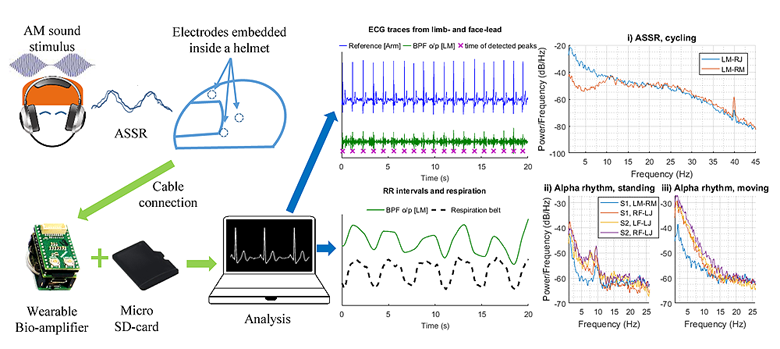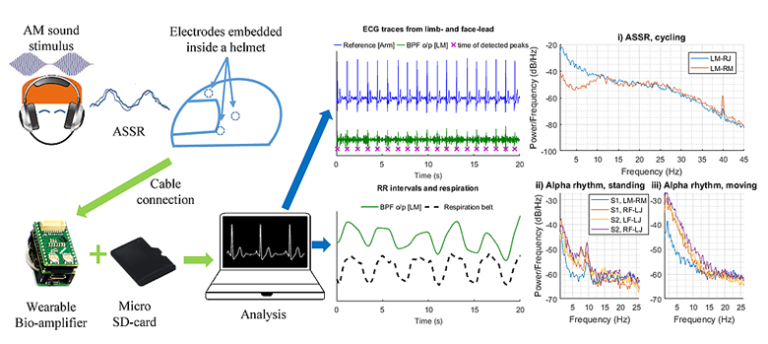
Modern wearable technologies have enabled continuous recording of vital signs, however, for activities such as cycling, motor-racing, or military engagement, a helmet with embedded sensors would provide maximum convenience and the opportunity to monitor simultaneously both the vital signs and the electroencephalogram (EEG). To this end, we investigate the feasibility of recording the electrocardiogram (ECG), respiration, and EEG from face-lead locations, by embedding multiple electrodes within a standard helmet. The electrode positions are at the lower jaw, mastoids, and forehead, while for validation purposes a respiration belt around the thorax and a reference ECG from the chest serve as ground truth to assess the performance. The within-helmet EEG is verified by exposing the subjects to periodic visual and auditory stimuli and screening the recordings for the steady-state evoked potentials in response to these stimuli. Cycling and walking are chosen as real-world activities to illustrate how to deal with the so-induced irregular motion artifacts, which contaminate the recordings. We also propose a multivariate R-peak detection algorithm suitable for such noisy environments. Recordings in real-world scenarios support a proof of concept of the feasibility of recording vital signs and EEG from the proposed smart helmet.
Editor’s Comment
Clinical Editor, Steven Schachter, MD
 A helmet-based system to monitor, integrate, and analyze in real-time multiple physiological signals, including electroencephalogram (EEG), electrocardiogram (ECG), and respiration, with sufficient fidelity in spite of potential sources of artifacts would be of great interest in settings where helmets are routinely worn and where sudden changes of EEG, ECG, and respiration may occur that require urgent action upon detection.
A helmet-based system to monitor, integrate, and analyze in real-time multiple physiological signals, including electroencephalogram (EEG), electrocardiogram (ECG), and respiration, with sufficient fidelity in spite of potential sources of artifacts would be of great interest in settings where helmets are routinely worn and where sudden changes of EEG, ECG, and respiration may occur that require urgent action upon detection.
Rosenberg et al. have shown the feasibility of such a system, which could be adapted quickly to specific applications, such as in military helmets where the viability of an injured soldier needs to be known to guide rescue efforts ir incorporated into helmets that persons with severe epilepsy wear to protect their heads from seizure-related injury, where the combination of sensors could alert to both seizure occurrence and for respiratory or cardiac compromise that has been associated with Sudden Unexpected Death in Epilepsy (SUDEP).

